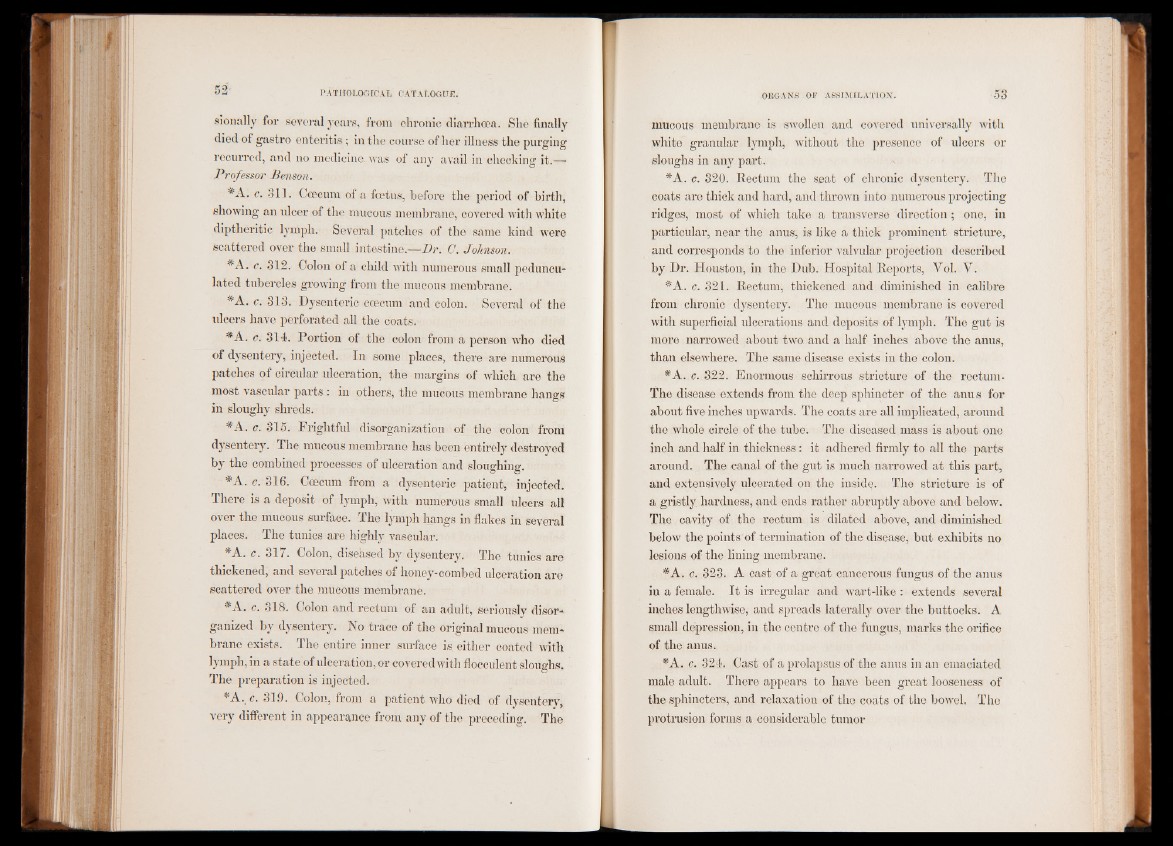
sionally for several years, from chronic diarrhoea. She finally
died of gastro enteritis ; in the course of her illness the purging
recurred, and no medicine- was of any avail in checking it.—■
Professor Benson.
#A. c. 811. Cæcum of a foetus, before the period of birth,
showing an ulcer of the mucous membrane, covered with white
diptheritic lymph. Several patches of the same kind were
scattered over the small intestine.—Dr. C. Johnson.
*A. c. 312. Colon of a child with numerous small pedunculated
tubercles growing from the mucous membrane.
#A. c. 313. Dysenteric cæcum and colon. Several of the
ulcers have perforated all the coats.
#A. o. 314. Portion of the colon from a person who died
of dysentery, injected. In some places, there are numerous
patches of circular ulceration, the margins of which are the
most vascular parts : in others, the mucous membrane hang's o in sloughy shreds.
#A. c. 315. Frightful disorganization of the colon from
dysentery. The mucous membrane has been entirely destroyed
by the combined processes of ulceration and sloughing.
*A. c. 316. Cæcum from a dysenteric patient, injected.
There is a deposit of lymph, with numerous small ulcers all
over the mucous surface. The lymph hangs in flakes in several
places. The tunics are highly vascular.
*A. c. 317. Colon, diseksed by dysentery. The tunics are
thickened, and several patches of honey-combed ulceration are
scattered over the mucous membrane.
#A. c. 318. Colon and rectum of an adult, seriously disorganized
by dysentery. No trace of the original mucous membrane
exists. The entire inner surface is, either coated with
lymph, in a state of ulceration, or covered with flocculent slouOghs. The preparation is injected.
*A. c. 319. Colon, from a patient who died of dysentery,
very different in appearance from any of the preceding. The
mucous membrane is swollen and covered universally with
white granular lymph, without the presence of ulcers or
sloughs in any part.
*A. c. 320. Rectum the seat of chronic dysentery. The
coats are thick and hard, and thrown into numerous projecting
ridges, most of which take a transverse direction; one, in
particular, near the anus, is like a thick prominent stricture,
and corresponds to the inferior valvular projection described
by Dr. Houston, in the Dub. Hospital Reports, Vol. V.
*A. c. 821. Rectum, thickened and diminished in calibre
from chronic dysentery. The mucous membrane is covered
with superficial ulcerations and deposits of lymph. The gut is
more narrowed about two and a half inches above the anus,
than elsewhere. The same disease exists in the colon.
#A. c. 322. Enormous schirrous stricture of the rectum.
The disease extends from the deep sphincter of the anus for
about five inches upwards. The coats are all implicated, around
the whole circle of the tube. The diseased mass is about one
inch and half in thickness: it adhered firmly to all the parts
around. The canal of the gut is much nai’rowed at this part,
and extensively ulcerated on the inside. The stricture is of
a gristly hardness, and ends rather abruptly above and below.
The cavity of the rectum is dilated above, and diminished
below the points of termination of the disease, but exhibits no
lesions of the lining membrane.
#A. c. 323. A cast of a great cancerous fungus of the anus
in a female. It is irregular and wart-like : extends several
inches lengthwise, and spreads laterally over the buttocks. A
small depression, in the centre of the fungus, marks the orifice
of the anus.
*A. c. 324. Oast of a prolapsus of the anus in an emaciated
male adult. There appears to have been great looseness of
the sphincters, and relaxation of the coats of the bowel. The
protrusion forms a considerable tumor